GE TCS18, TCD18, TCC18, TDC18, TCX18 User Manual
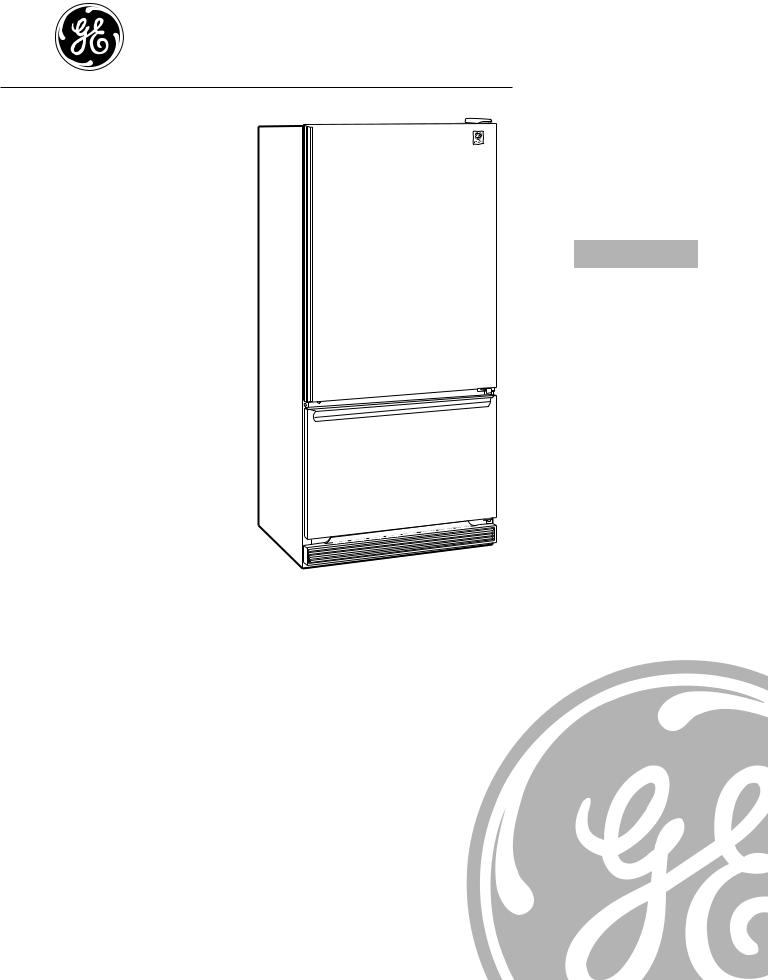
Refrigerators
Bottom-Mount No-Frost
GE Appliances
Owner’s Manual
Models
TCX18
TCC18
TDC18
TCD18
TCS18
Part No. 162D9629P004 Pub. No. 49-60085 WR6M433 02-00 JR
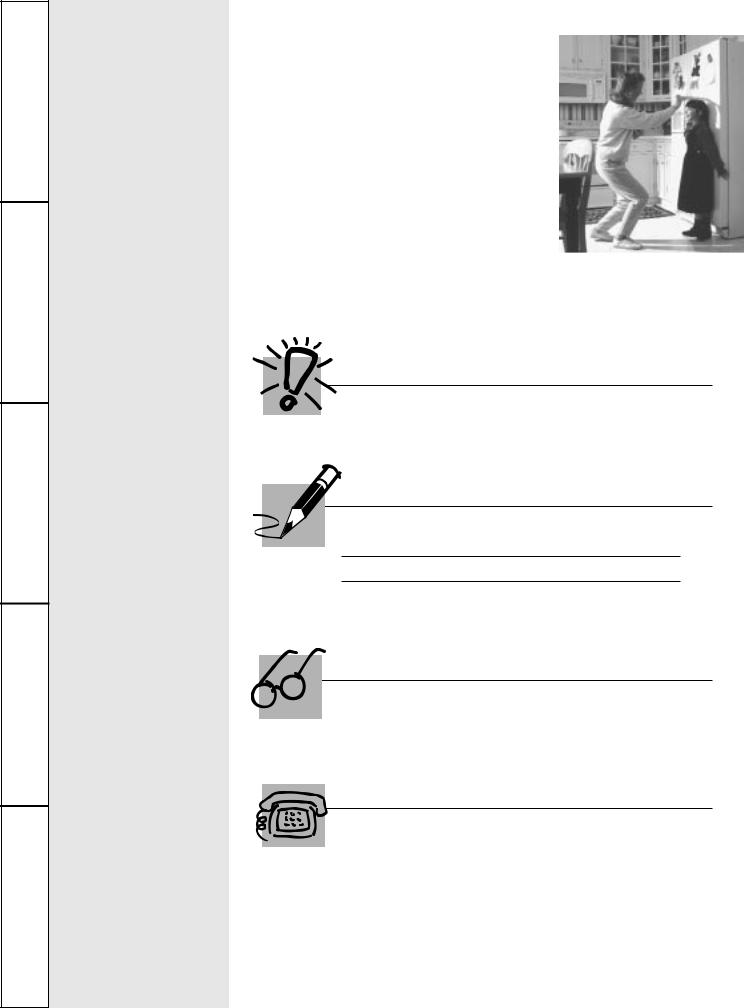
Troubleshooting Tips Installation Instructions Operating Instructions Safety Instructions
Customer Service
Safety Information
Safety Precautions . . . . . . . . . .3 Use of Extension Cords . . . . . .3 How to Connect Electricity . . .4 Use of Adapter Plugs . . . . . . . .4
Operating Instructions
Controls . . . . . . . . . . . . . . . . . .5
Features . . . . . . . . . . . . . . . .6–9
Care and Cleaning . . . . . .10, 11
Installation Instructions
Preparing to
Install the Refrigerator . . . . . .12 Reversing the Door Swing 13–16
Troubleshooting Tips
Normal Operating Sounds . . .17
Before You
Call For Service . . . . . . . .17–19
Customer Service
Warranty
for Canadian Customers . . . .20
Warranty
for U.S. Customers . . . . . . . . .21
Service Telephone
Numbers . . . . . . . . . . . . . . . .22
2
Congratulations!
We’re proud of our quality products and we are committed to providing dependable service. You’ll see it in this easy-to-use Owner’s Manual and you’ll hear it in the friendly voices of our customer service department.
Best of all, you’ll experience these values each time you use your refrigerator. That’s important, because your new refrigerator will be part of your family for many years. And we hope you will be part of ours for a long time to come.
We appreciate your purchase, and hope you will continue to rely on us whenever you need quality appliances for your home.
A Service Partnership.
IMPORTANT!
Staple sales slip or cancelled check here.
Proof of the original purchase date is needed to obtain service under the warranty.
FOR YOUR RECORDS
Write the model and serial numbers here:
#
#
You can find them on a label on the left side, near the top of the freezer compartment.
READ THIS MANUAL
Inside you will find many helpful hints on how to use and maintain your refrigerator properly. Just a little preventive care on your part can save you a great deal of time and money over the life of your refrigerator.
IF YOU NEED SERVICE
You’ll find many answers to common problems in the Before You Call For Service section. If you review our chart of Troubleshooting Tips first, you may not need to call for service at all.
If you do need service, you can relax knowing help is only a phone call away. A list of toll-free customer service numbers is included in the back section. Or, in the U.S., you can always call the GE Answer Center® at 800.626.2000, 24 hours a day, 7 days a week. In Canada, call 1-800-361-3400.
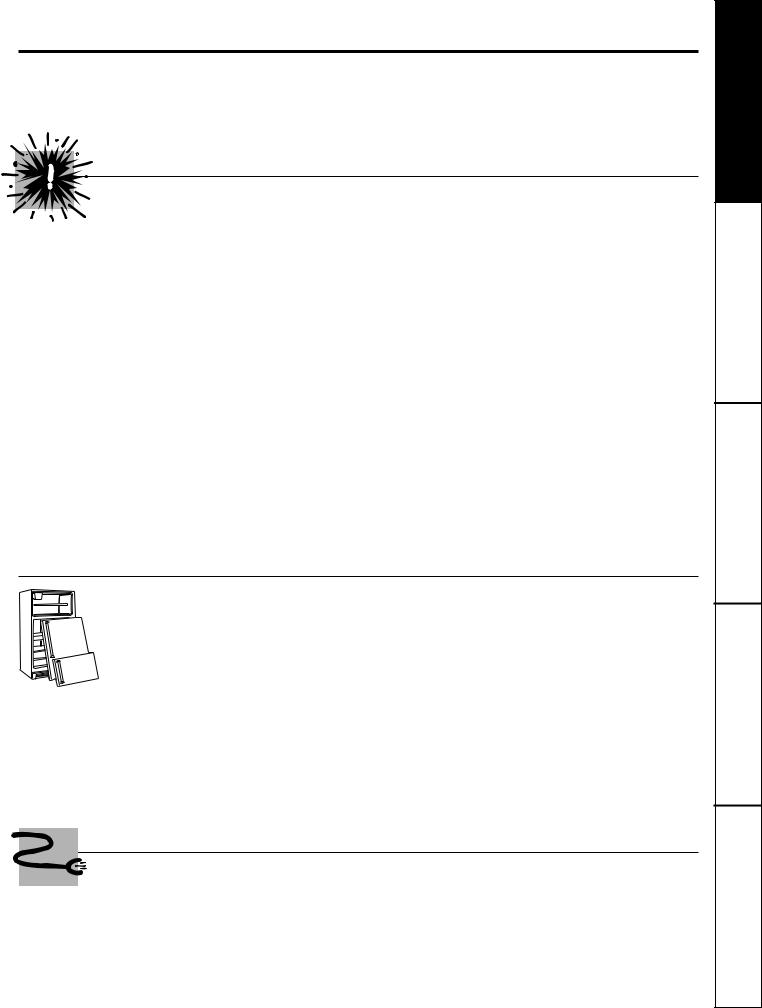
IMPORTANT SAFETY INFORMATION.
READ ALL INSTRUCTIONS BEFORE USING.
 WARNING!
WARNING!
Use this appliance only for its intended purpose as described in this Owner’s Manual.
SAFETY PRECAUTIONS
When using electrical appliances, basic safety precautions should be followed, including the following:
■This refrigerator must be properly installed and located in accordance with the Installation Instructions before it is used.
■Do not allow children to climb, stand or hang on the shelves in the refrigerator. They could damage the refrigerator and seriously injure themselves.
■Do not touch the cold surfaces in the freezer compartment when hands are damp or wet. Skin may stick to these extremely cold surfaces.
■Do not store or use gasoline or other flammable vapors and liquids in the vicinity of this or any other appliance.
■Do not refreeze frozen foods which have thawed completely.
■Keep fingers out of the “pinch point” areas; clearances between the doors and between the doors and cabinet are necessarily small. Be careful closing doors when children are in the area.
■Unplug the refrigerator before cleaning and making repairs.
NOTE: We strongly recommend that any servicing be performed by a qualified individual.
■Before replacing a burned-out light bulb, unplug the refrigerator or turn off power at the circuit breaker or fuse box in order to avoid contact with a live wire filament. (A burned-out light bulb may break when being replaced.)
■Turning the control to the OFF position does not remove power to the light circuit.
 DANGER! RISK OF CHILD ENTRAPMENT
DANGER! RISK OF CHILD ENTRAPMENT
PROPER DISPOSAL OF THE REFRIGERATOR
Child entrapment and suffocation are not problems of the past. Junked or abandoned refrigerators are still dangerous…even if they will sit for “just a few days.” If you are getting rid of your old refrigerator, please follow the instructions below to help prevent accidents.
Before You Throw Away Your Old Refrigerator or Freezer:
■Take off the doors.
■Leave the shelves in place so that children may not easily climb inside.
CFC Disposal
Your old refrigerator has a cooling system that used CFCs (chlorofluorocarbons). CFCs are believed to harm stratospheric ozone.
If you are throwing away your old refrigerator, make sure the CFC refrigerant is removed for proper disposal by a qualified servicer. If you intentionally release this CFC refrigerant you can be subject to fines and imprisonment under provisions of environmental legislation.
USE OF EXTENSION CORDS
Because of potential safety hazards under certain conditions, we strongly recommend against the use of an extension cord.
However, if you must use an extension cord, it is absolutely necessary that it be a UL-listed (in the United States) or a CSA certified (in Canada), 3-wire grounding type appliance extension cord having a grounding type plug and outlet and that the electrical rating of the cord be 15 amperes (minimum) and 120 volts.
3
Tips Troubleshooting Instructions Installation Instructions Operating Instructions Safety
Service Customer
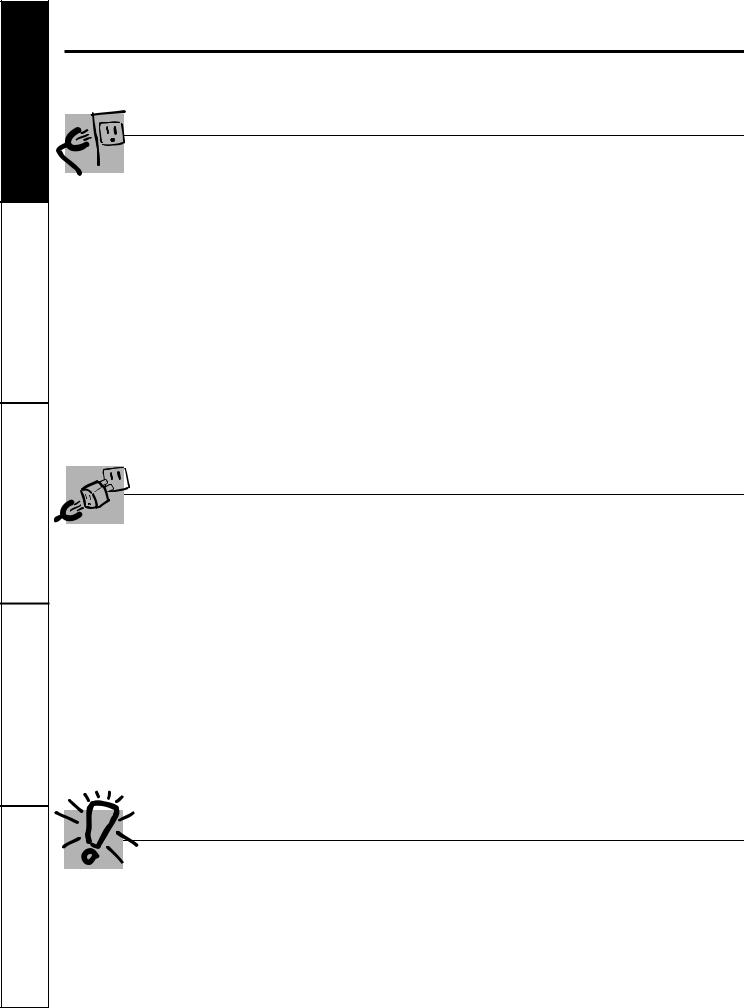
TroubleshootingTips InstallationInstructions OperatingInstructions Safety Instructions
CustomerService
IMPORTANT SAFETY INFORMATION.
READ ALL INSTRUCTIONS BEFORE USING.
 WARNING!
WARNING!
HOW TO CONNECT ELECTRICITY
Do not, under any circumstances, cut or remove the third (ground) prong from the power cord. For personal safety, this appliance must be properly grounded.
The power cord of this appliance is equipped with a 3-prong (grounding) plug which mates with a standard 3-prong (grounding) wall outlet to minimize the possibility of electric shock hazard from this appliance.
Have the wall outlet and circuit checked by a qualified electrician to make sure the outlet is properly grounded.
Where a standard 2-prong wall outlet is encountered, it is your personal responsibility and obligation to have it replaced with a properly grounded 3-prong wall outlet.
The refrigerator should always be plugged into its own individual electrical outlet which has a voltage rating that matches the rating plate.
This provides the best performance and also prevents overloading house wiring circuits which could cause a fire hazard from overheated wires.
Never unplug your refrigerator by pulling on the power cord. Always grip plug firmly and pull straight out from the outlet.
Repair or replace immediately all power cords that have become frayed or otherwise damaged. Do not use a cord that shows cracks or abrasion damage along its length or at either end.
When moving the refrigerator away from the wall, be careful not to roll over or damage the power cord.
USE OF ADAPTER PLUGS (Adapter plugs not permitted in Canada)
Because of potential safety hazards under certain conditions, we strongly recommend against the use of an adapter plug.
However, if you must use an adapter, where local codes permit, a temporary connection may be made to a properly grounded 2-prong wall outlet by use of a UL-listed adapter available at most local hardware stores.
The larger slot in the adapter must be aligned with the larger slot in the wall outlet to provide proper polarity in the connection of the power cord.
When disconnecting the power cord from the adapter, always hold the adapter in place with one hand while pulling the power cord plug with the other hand. If this is not done, the adapter ground terminal is very likely to break with repeated use.
If the adapter ground terminal breaks, DO NOT USE the refrigerator until a proper ground has been established.
Attaching the adapter ground terminal to a wall outlet cover screw does not ground the appliance unless the cover screw is metal and not insulated, and the wall outlet is grounded through the house wiring. You should have the circuit checked by a qualified electrician to make sure the outlet is properly grounded.
Read and follow this Safety Information carefully.
SAVE THESE INSTRUCTIONS
4
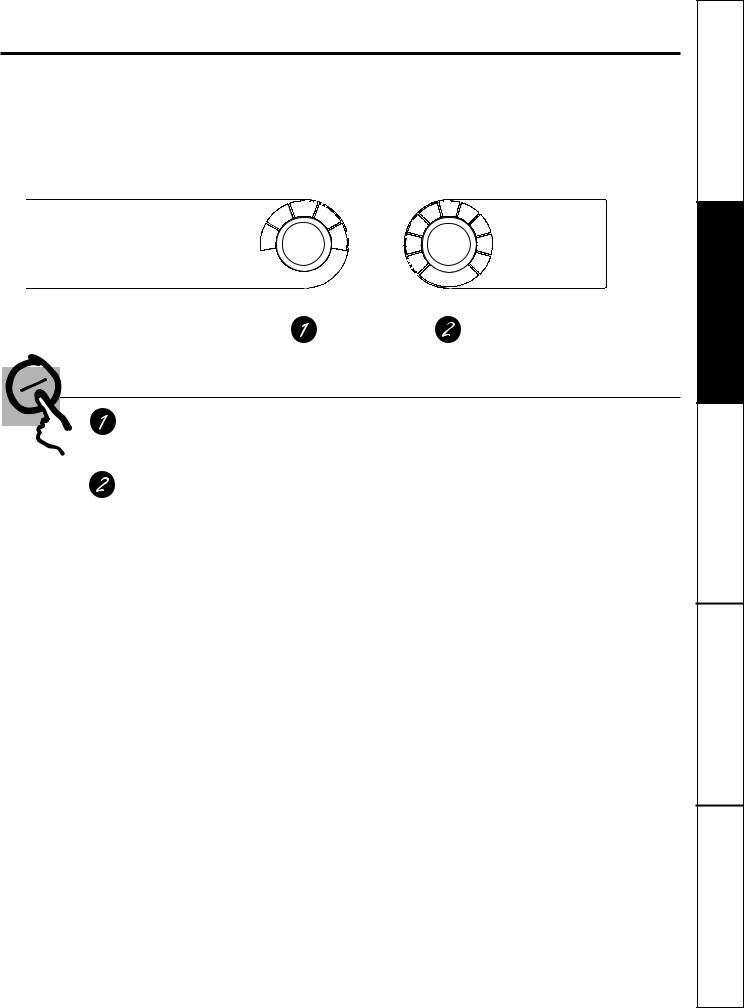
About the controls on the refrigerator.
The temperature controls on your refrigerator have letters |
If you want colder or warmer temperatures, adjust the |
and numbers. Initially set the refrigerator control at 5 and |
refrigerator temperature first. When satisfied with that |
the freezer control at C. |
setting, adjust the freezer temperature. |
|
|
Temperature Control Center |
|
|
|
|
|
|
|
|
|
|
|
Centre de température |
|||||||
Freezer Congélateur |
|
|
|
|
|
|
|
|
|
|
REFRIGERATOR |
RÉFRIGÉRATEUR |
|||||||
|
|
|
|
C |
|
|
|
|
|||||||||||
Initial setting |
|
|
|
D |
|
4 5 |
6 |
Initial setting |
|||||||||||
"C" |
|
B |
|
3 |
|
|
7 |
"5" |
|
||||||||||
Réglage de départ |
A |
|
|
|
E |
2 |
|
|
8 |
Réglage de départ |
|||||||||
|
|
|
|
|
|
|
|
|
|
|
|
|
|
|
|
|
|||
Coldest |
|
|
|
|
|
|
|
|
1 |
|
|
9 |
Coldest |
||||||
"E" |
|
|
|
|
|
|
|
|
|
|
"9" |
|
|||||||
Plus froid |
|
|
|
|
|
|
|
|
|
O |
|
|
T |
Plus froid |
|||||
|
|
|
|
|
|
|
|
|
FF • ARR |
|
|||||||||
|
|
|
|
|
|
|
|
|
|
|
|
|
|
Ê |
|
|
|
||
|
|
|
|
|
|
|
|
|
|
|
|
|
|
|
|
|
|
|
|
|
|
|
|
|
|
|
|
|
|
|
|
|
|
|
|
|
|
|
|
Control Settings
Freezer Control
The freezer control moves a damper to change the amount of cold air that moves from the freezer to the refrigerator compartment.
Refrigerator Control
The refrigerator control maintains the temperatures throughout the refrigerator.
Moving the refrigerator control to OFF stops cooling in both areas—refrigerator and freezer—but does not shut off power to the refrigerator.
How To Test Temperatures
Use the milk test for the refrigerator compartment. Place a container of milk on the top shelf and check it a day later. If the milk is too warm or too cold, adjust the temperature control.
Use the ice cream test for the freezer compartment. Place a container of ice cream in the center of the freezer and check it after a day. If it’s too hard or too soft, adjust the temperature control.
After changing the controls, allow 24 hours for the refrigerator to reach the temperature you have set.
Food Storage
The type of packaging used and the storage temperatures will affect how long food will keep in the refrigerator.
New food storage guidelines are constantly being developed.
5
Tips Troubleshooting Instructions Installation Instructions Operating Instructions Safety
Service Customer
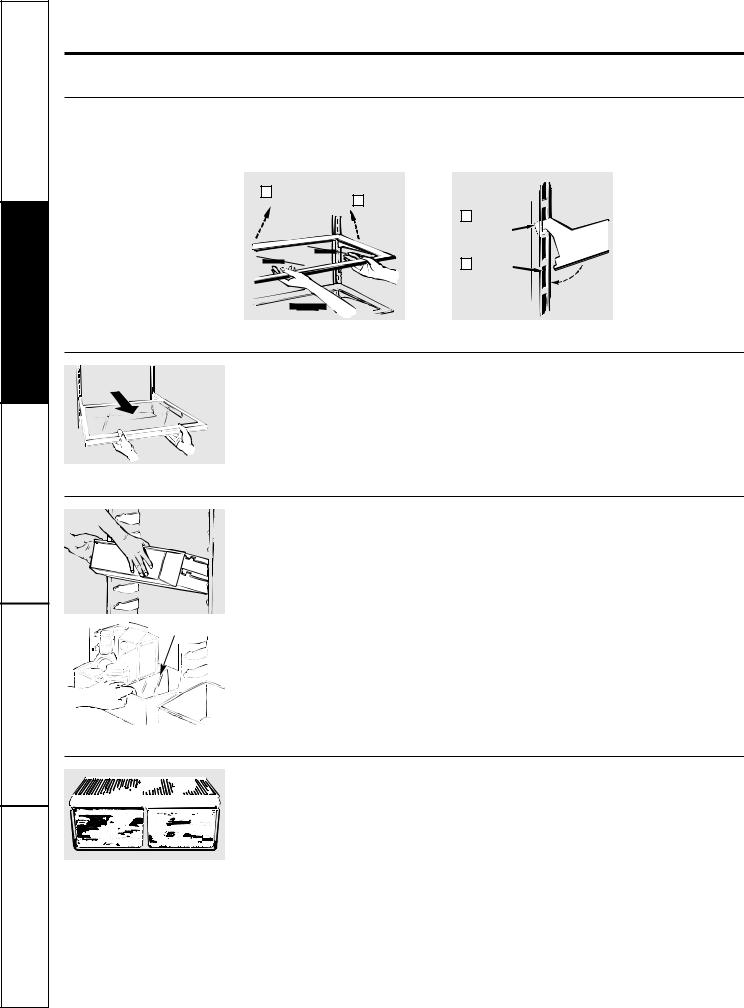
TroubleshootingTips InstallationInstructions Operating Instructions SafetyInstructions
CustomerService
About the refrigerator shelves, bins and storage drawers.
Not all features are on all models.
Rearranging the Shelves
Glass and wire shelves in the refrigerator compartment are adjustable.
To Remove |
|
To Replace |
|
2 Lift up and out |
1 |
Tilt up |
|
|
|
||
|
|
1 |
Insert |
|
|
|
top hook |
|
|
2 |
Lower to |
|
|
|
lock in place |
Slide-Out Spillproof Shelf
The slide-out spillproof shelf allows you |
Make sure you push the shelves all the way back |
to reach items stored behind others. The |
in before you close the door. |
special edges are designed to help prevent |
|
spills from dripping to lower shelves. |
|
Adjustable Door Bins
Adjustable bins can easily be carried from refrigerator to work area.
To remove: Tilt the bin up and pull out on the molded supports until it comes completely out of the door.
Snugger |
To replace or relocate: Select desired height, |
|
engage the bin in the molded supports of |
|
the door and slide the bin in. The bin will |
|
hook in place. |
|
|
The snuggers help prevent tipping, spilling or sliding of small items stored on the door shelf. Place a finger on either side of the divider near the front and move it back and forth to fit your needs.
Fruit and Vegetable Drawers
Excess water that may accumulate in the bottom of the drawers should be emptied and the drawers wiped dry.
6
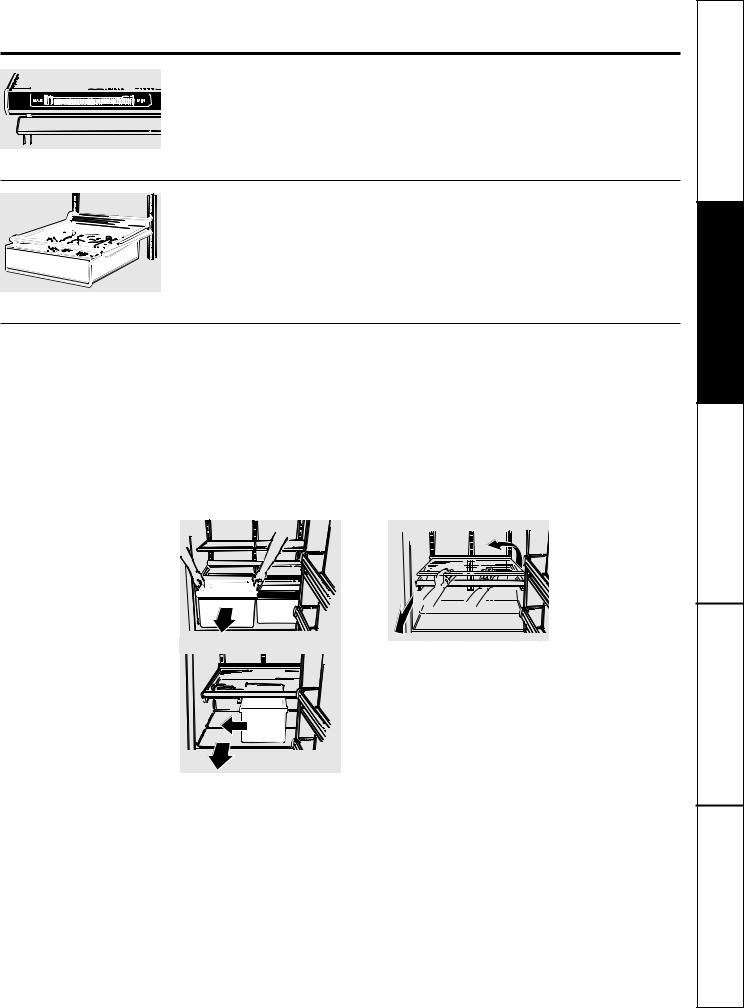
Adjustable Humidity Drawers
Slide the control all the way to the MAX |
Slide the control all the way to the MIN |
setting to provide high humidity |
setting to provide lower humidity levels |
recommended for most vegetables. |
recommended for most fruits. |
Detachable Meat Drawer
The slide-out meat drawer can be |
The drawer and the adjustable shelf |
removed and taken to the sink or food |
to which it attaches can be relocated |
preparation area. |
at any level. |
Storage Drawer and Cover Removal
To Remove:
These drawers can be removed easily by lifting up slightly while pulling the drawers past the stop location.
When the door cannot be opened enough to pull the drawer straight out, slide the drawer toward the middle and remove it.
Remove the glass, then the frame. When replacing the glass, push the rear edge firmly into the frame.
Step 1 |
Step 2 |
7
Tips Troubleshooting Instructions Installation Instructions Operating Instructions Safety
Service Customer
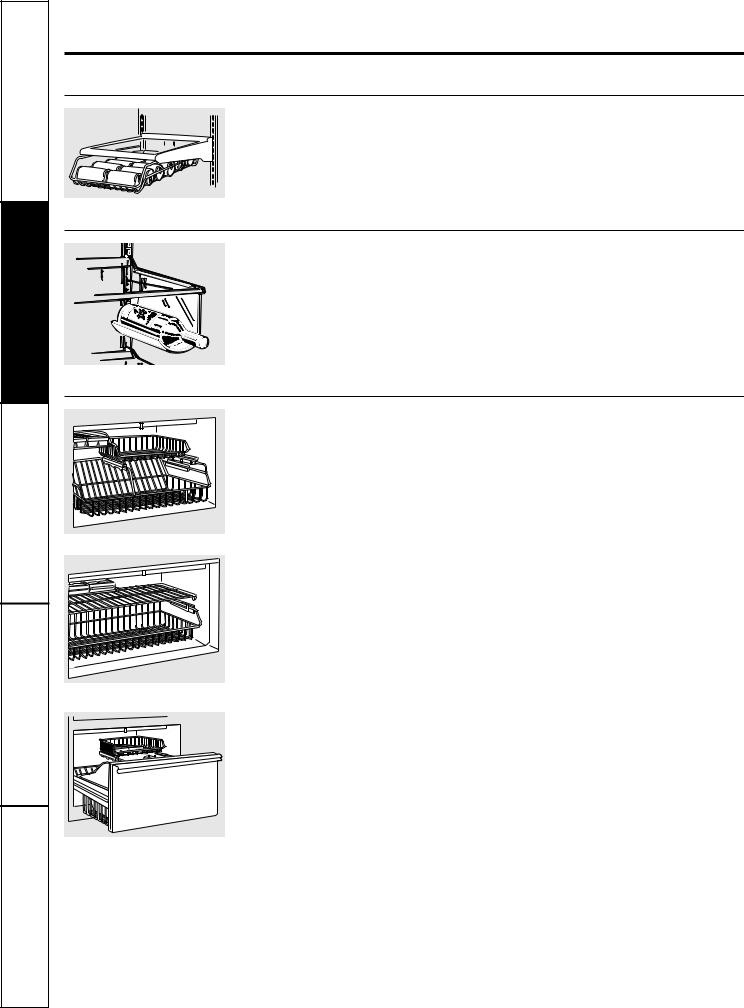
TroubleshootingTips InstallationInstructions Operating Instructions SafetyInstructions
CustomerService
Some additional features.
Not all features are on all models.
Beverage Rack
This slide-out rack provides storage for a |
The rack and the adjustable shelf to which |
variety of beverages. |
it attaches can be relocated to any level. |
Removable Wine Rack
This rack is designed to hold a bottle on its side.
Freezer Shelves and Baskets
On swing door models with two sliding baskets: Both the lower and upper baskets slide out to provide easy access to foods stored in the freezer. When the lower basket is pulled out, the upper basket may be pushed back to further improve access
to the lower basket.
On swing door models with one sliding basket and one full width fixed shelf:
The lower basket slides out to provide easy access to foods stored in this basket.
The top full width fixed shelf provides a convenient location to store ice cube trays and ice bucket as well as a variety of foods.
(Appearance may vary)
On drawer models: The lower basket slides out when the door is opened to provide easy access to foods stored in this basket. The upper basket may be pushed back to further improve access to the lower basket.
Both baskets may be easily removed for cleaning spills or crumbs off the freezer floor, or for installing an icemaker.
8

Automatic Icemaker Kit (optional at extra cost)
An Automatic Icemaker Kit is available |
If your model came with an ice bucket and |
at extra cost. Check the back of the |
icemaker extension arm, they will need to |
refrigerator for the specific icemaker kit |
be used if you install an icemaker. If the |
needed for your model. |
bucket or extension arm have been |
|
misplaced, they will need to be ordered |
|
before installing the icemaker. |
Water Filter Accessory (optional at extra cost)
The water filter is an option at extra cost |
It has complete installation instructions and |
and is available from your dealer. Specify |
installs on 1/4″ O.D. copper water line. |
WR97X0214. |
|
Ice Cube Tray Shelf (on some models)
Some models have a small separate shelf for ice cube trays.
Ice Trays and Bucket (on some models)
To remove ice cubes from tray, place the tray upside down on bucket as shown. Press down on the tray and the cubes will pop out.
Large Ice Bucket (on some models)
A larger ice bucket is provided in some models to give greater ice storage capacity. It can also be removed and used as a utility bucket in the fresh food section, giving more capacity in the freezer section.
9
Tips Troubleshooting Instructions Installation Instructions Operating Instructions Safety
Service Customer
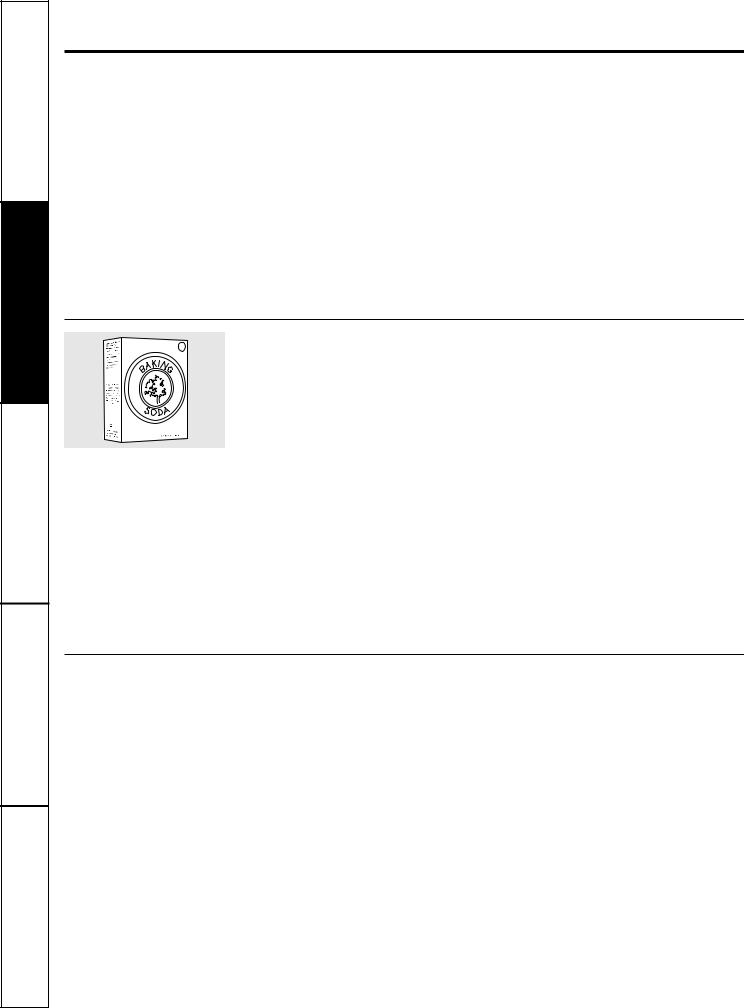
TroubleshootingTips InstallationInstructions Operating Instructions SafetyInstructions
CustomerService
Care and cleaning of the refrigerator.
Cleaning the Outside
Keep the outside clean. Wipe with a clean cloth lightly dampened with mild liquid dish detergent. Dry and polish with a clean, soft cloth.
Do not wipe the refrigerator with a soiled dish cloth or wet towel. These may leave a residue that can erode the paint. Do not use scouring pads, powdered cleaners, bleach or cleaners containing bleach because these products can scratch and weaken the paint finish.
Stainless steel panels and door handles
(on some models) should be cleaned with a commercially available stainless steel cleaner, wiping the surface along the grain of the metal with a clean, soft cloth.
Stainless steel can also be cleaned with a wet cloth using a solution of soap and warm water. Dry the surface with a clean, soft cloth wiping the surface along the grain of the metal.
Do not use appliance wax or polish on the stainless steel.
Cleaning the Inside
To help prevent odors, leave an open box of baking soda in the fresh food and freezer compartments.
Unplug the refrigerator before cleaning. If this is not practical, wring excess moisture out of sponge or cloth when cleaning around switches, lights or controls.
Use warm water and baking soda solution— about a tablespoon (15 ml) of baking soda to a quart (1 l) of water. This both cleans and neutralizes odors. Rinse and wipe dry.
After cleaning the door gaskets, apply a thin layer of petroleum jelly to the door gaskets at the hinge side. This helps keep the gaskets from sticking and bending out of shape.
Avoid cleaning cold glass shelves (on some models) with hot water because the extreme temperature difference may cause them to break. Handle glass shelves carefully. Bumping tempered glass can cause it to shatter.
Do not wash any plastic refrigerator parts in the dishwasher.
Behind the Refrigerator
Be careful when moving the refrigerator away from the wall. All types of floor coverings can be damaged, particularly cushioned coverings and those with embossed surfaces.
Pull the refrigerator straight out and return it to position by pushing it straight in. Moving the refrigerator in a side direction may result in damage to the floor covering or refrigerator.
When pushing the refrigerator back, make sure you don’t roll over the power cord.
10
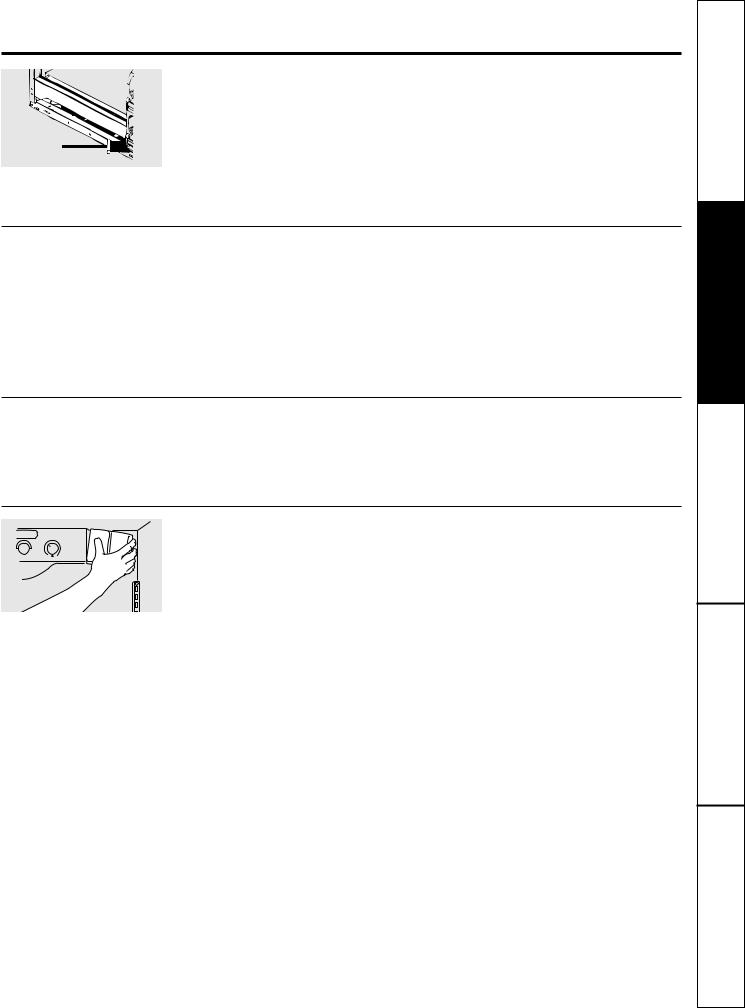
Under the Refrigerator
For most efficient operation, keep the area under the refrigerator clean. Remove the base grille and sweep away or vacuum up dust.
Clean the condenser coils at least twice a year.
For best results, use a brush specially designed for this purpose. It is available at most appliance parts stores.
Preparing for Vacation
For long vacations or absences, remove food and unplug the refrigerator. Move the control to the OFF position, and clean the interior with a baking soda solution of one tablespoon (15 ml) of baking soda to one quart (1 l) of water. Leave the doors open.
If an icemaker is installed, move the icemaker feeler arm to the STOP (up) position and shut off the water supply to the refrigerator.
Preparing to Move
Secure all loose items such as grille, |
Be sure the refrigerator stays in an upright |
shelves and drawers by taping them |
position during moving. |
securely in place to prevent damage. |
|
Replacing the Light Bulb
To replace a burned-out bulb, unplug the refrigerator from its electrical outlet.
In the refrigerator compartment, remove the lens cover by gently applying pressure to the side of the lens cover and pull the cover free from the control housing. Unscrew the bulb when cool and replace it with an appliance bulb of the same or lower wattage.
In the freezer compartment, simply unscrew and replace the bulb after ensuring the refrigerator is unplugged.
Turning the control to the OFF position does not remove power to the light circuit.
11
Tips Troubleshooting Instructions Installation Instructions Operating Instructions Safety
Service Customer
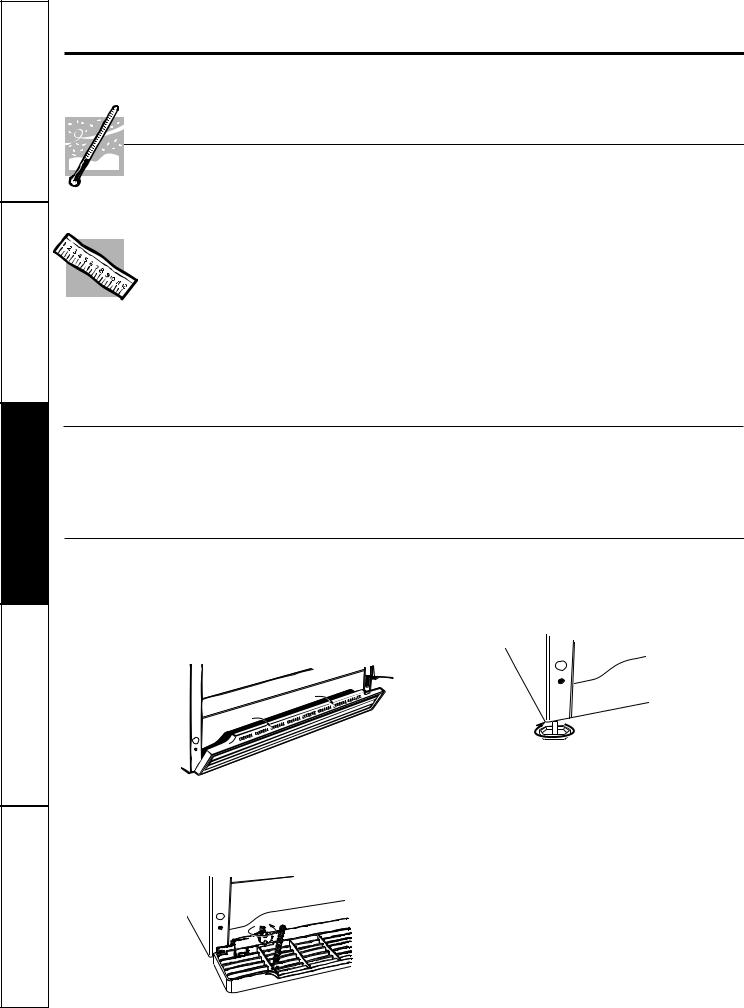
TroubleshootingTips Installation Instructions OperatingInstructions SafetyInstructions
CustomerService
Preparing to install the refrigerator.
Read these instructions completely and carefully.
Refrigerator Location
Do not install the refrigerator where the |
Install it on a floor strong enough to support it |
temperature will go below 60°F (16°C) because |
fully loaded. |
it will not run often enough to maintain proper |
|
temperatures. |
|
Clearances |
|
Allow the following clearances for ease of installation and proper air circulation.
Sides |
0″ (0 mm) |
Top |
1″ (25 mm) |
Back* 11/4″ (32 mm)
*Metal cover on back may touch wall.
If refrigerator is to be installed against a wall on the hinge side, allow a minimum of 13/4″ (45 mm) between the wall and the side of the refrigerator to allow for door and handle clearance.
Packaging Tapes
Remove all packaging tapes and peel-off films. These tapes were added to secure and protect your refrigerator during transit.
Leveling
Your refrigerator comes with adjustable rollers and |
Adjustable legs are located at the front corners. |
adjustable legs. Either rollers or legs should be set so |
Turn the adjustable legs clockwise to raise the |
the refrigerator is firmly positioned on the floor and |
refrigerator, counterclockwise to lower it. |
the front is raised just enough that the doors close |
|
easily when opened about halfway. |
|
Tilt top out |
|
|
Turn adjustment leg clockwise |
|
to raise refrigerator |
|
Adjustable |
Base Grille |
Leg |
|
|
To adjust the rollers, tilt the base grille out |
|
exposing the adjustment screws. Using an |
|
adjustable wrench, turn the two front roller |
|
adjusting screws counterclockwise to raise the |
|
refrigerator, clockwise to lower it. |
|
Turn adjusting screw |
|
counterclockwise to raise |
|
refrigerator |
|
Adjustable |
|
Roller |
|
12
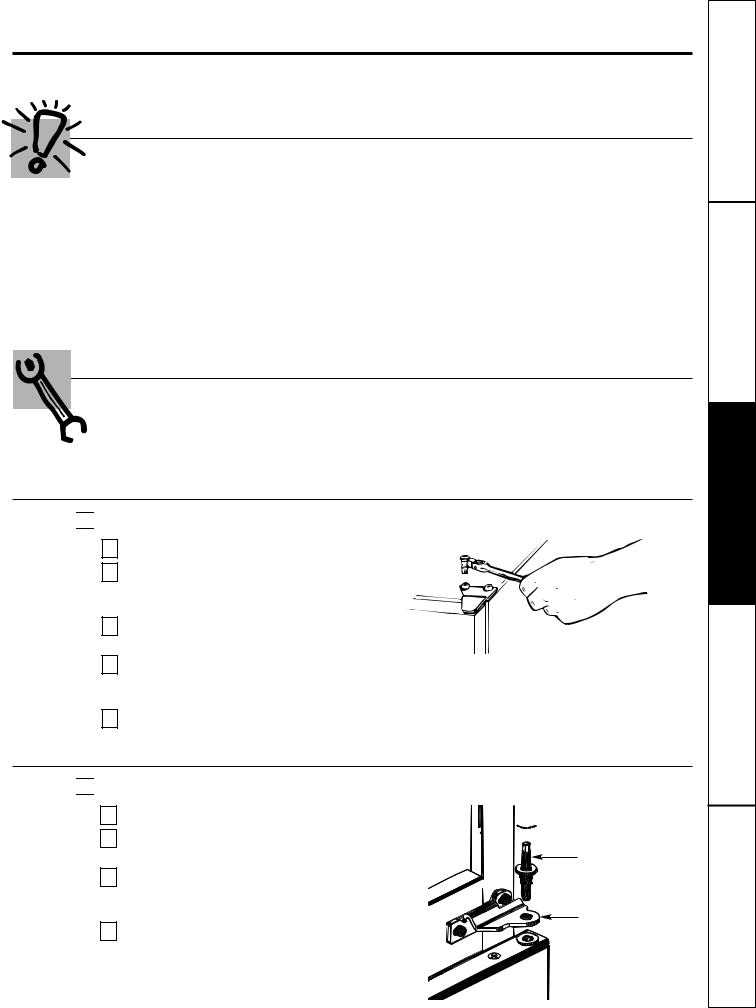
Reversing the door swing.
Read these instructions completely and carefully.
Before You Begin
When reversing the door swing:
■Read the instructions all the way through before starting.
■NOTE: Doors on stainless steel models are not reversible.
■Handle parts carefully to avoid scratching paint.
■Set screws down by their related parts to avoid using them in the wrong places.
■Provide a non-scratching work surface for the doors.
These instructions are for changing the hinges from the right side to the left side.
If you ever want to change the hinges back to the right side, follow these same instructions (merely reverse all references to left and right).
Unplug the refrigerator from its electrical outlet.
Empty all door shelves including the dairy compartment.
Tools Required
■Masking tape |
■Square head #2 screwdriver |
■Phillips screwdriver |
■7/32″, 5/16″ and 3/8″ sockets and ratchet |
■Putty knife or thin-blade screwdriver |
(6-point sockets are recommended) |
|
Removing the Doors


 Remove Refrigerator Door (Top Door) a Tape the door shut with masking tape.
Remove Refrigerator Door (Top Door) a Tape the door shut with masking tape.
b Remove the hinge cover (on some models). With a 5/16″ socket, remove the two screws that hold the top hinge to the cabinet.
c Lift the hinge straight up to free the hinge pin from the socket in the top of the door.
d Remove tape, tilt the door away from the cabinet and lift it to free its bottom socket from the hinge pin on the center hinge bracket.
e Set the door on a non-scratching surface with the outside up.


 Remove Freezer Door (Bottom Door) (For models with a freezer drawer, complete step 2b only.)
Remove Freezer Door (Bottom Door) (For models with a freezer drawer, complete step 2b only.)
a
b
c
d
Tape the door shut with masking tape.
Remove the hinge pin with a 7/32″ socket and ratchet.
Remove tape, tilt the door away from the cabinet. Remove and save the washer on the hinge pin.
Lift the door straight up to free its bottom socket from the pin in the bottom hinge bracket.

 Plastic Washer
Plastic Washer
Hinge Pin
Center Hinge Bracket |
 Freezer Door
Freezer Door
13
Tips Troubleshooting Instructions Installation Instructions Operating Instructions Safety
Service Customer
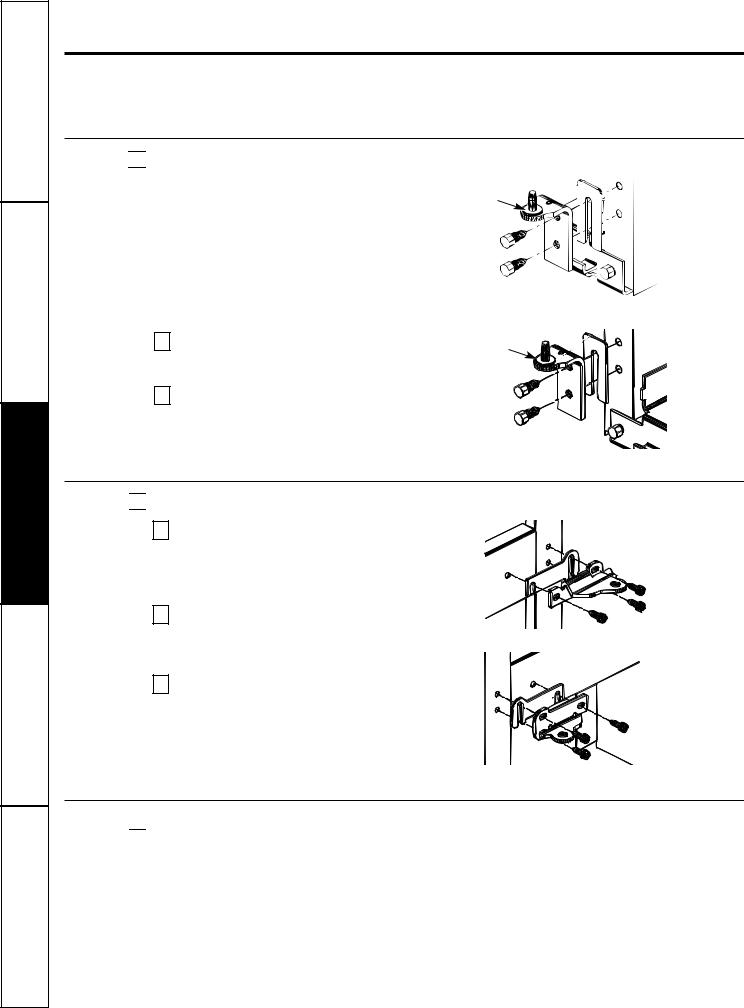
TroubleshootingTips Installation Instructions OperatingInstructions SafetyInstructions
CustomerService
Reversing the door swing.
Read these instructions completely and carefully.
Reversing the Hardware


 Transfer Bottom Hinge Bracket to the Left (For freezer swing door models only.)
Transfer Bottom Hinge Bracket to the Left (For freezer swing door models only.)
|
Pull out grille 1″ (25 mm) and set it down on the |
|
|
a |
Plastic |
||
floor to gain access to the hinge bracket screws. |
|||
Washer |
|||
|
|||
|
Using a 3/8″ socket, remove the hinge bracket, |
|
|
b |
|
||
screws, plastic washer and spacer shim from the |
|
||
|
|
||
|
bottom right side of the cabinet. |
|
Bottom Right
c |
Remove plug button and screw from the |
Plastic |
bottom left side of the cabinet and install at |
Washer |
|
|
the bottom right. |
|
d Reinstall the spacer shim, hinge bracket, screws and plastic washer to the bottom left
side of the cabinet.
Bottom Left


 Transfer Center Hinge Bracket to the Left
Transfer Center Hinge Bracket to the Left
a Remove the center hinge bracket and shim by removing the three screws. NOTE: Keep these screws with the hinge bracket. They are longer screws and will be used when installing the hinge on the other side.
b |
Remove the three painted screws and take |
Center Right |
washers from the center left side of the cabinet. |
||
|
Screw them into the holes on the right side, |
|
|
which were uncovered in Step “a” above. |
|
c Place the center hinge bracket and shim over
the holes at the center left side of the cabinet. Insert the three screws that were removed with
the center hinge bracket in Step “a” and
tighten securely.
Center Left
Do not install the hinge pin yet.


 Transfer Top Hinge to the Left
Transfer Top Hinge to the Left
Interchange hinge and shim at top right with two plug buttons at top left of cabinet. Do not tighten screws on hinge side at this time.
14
